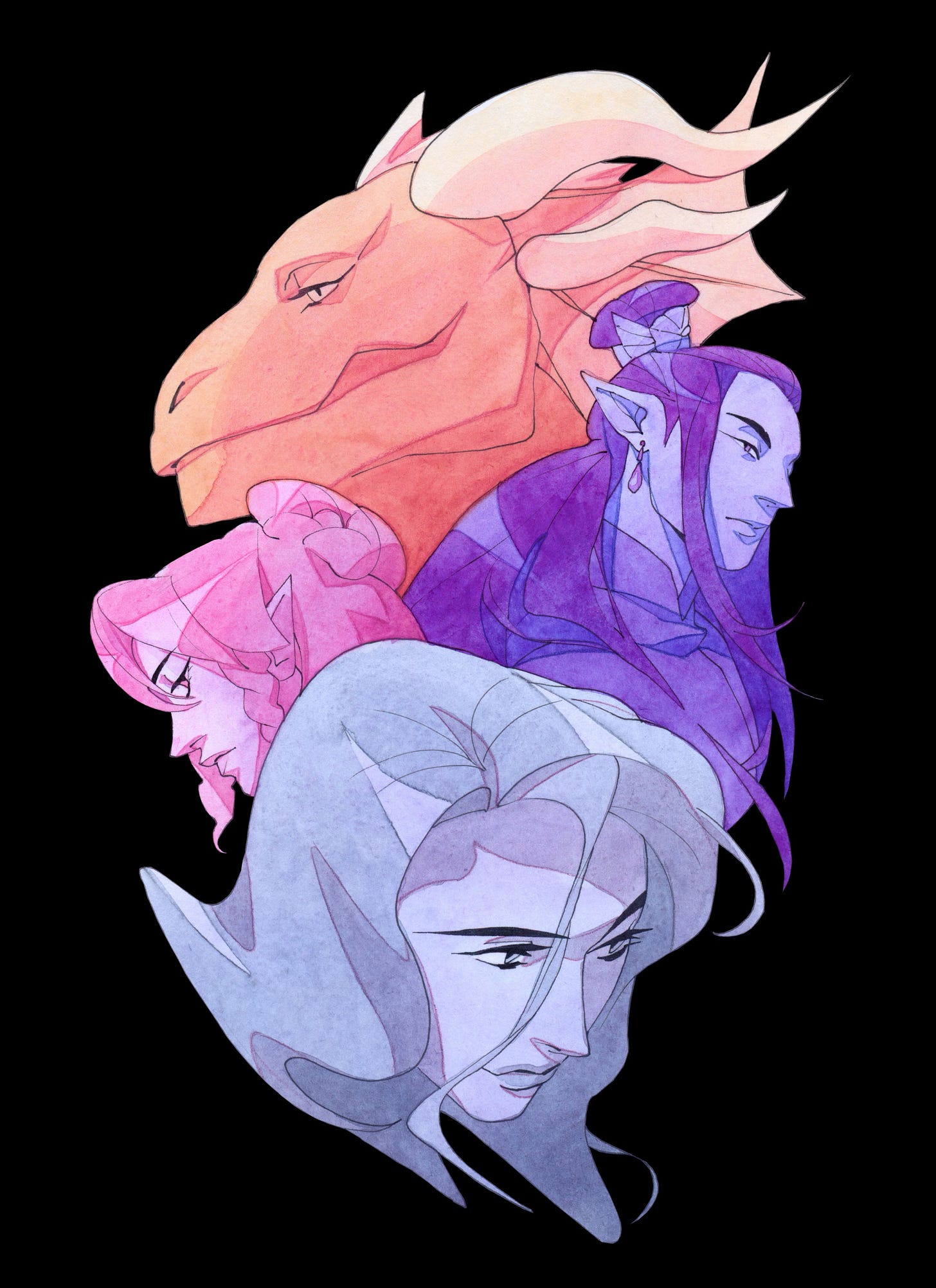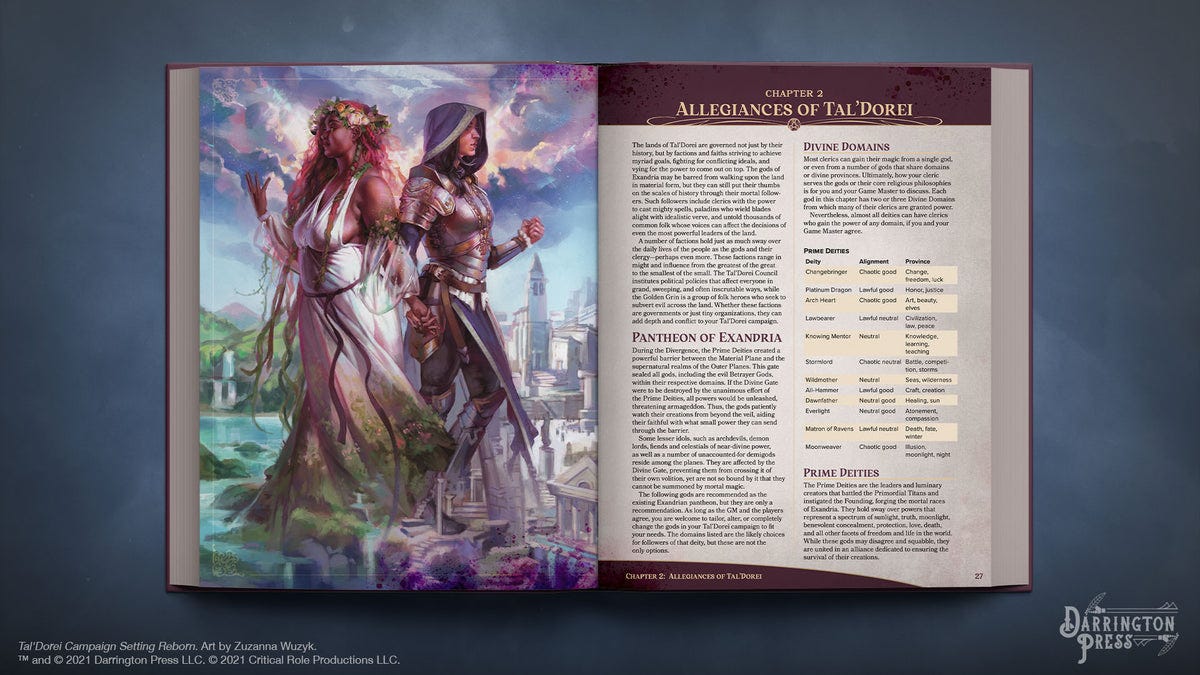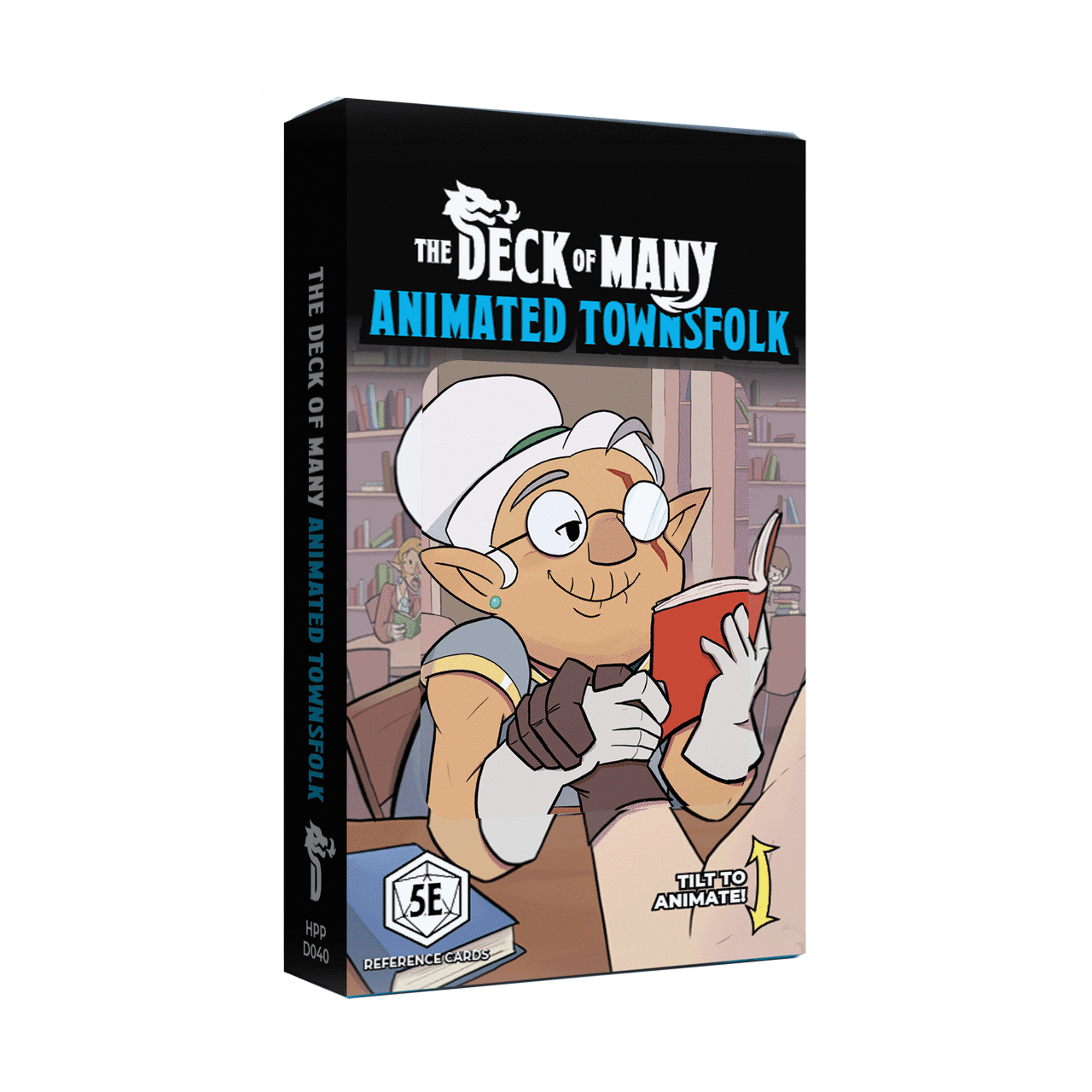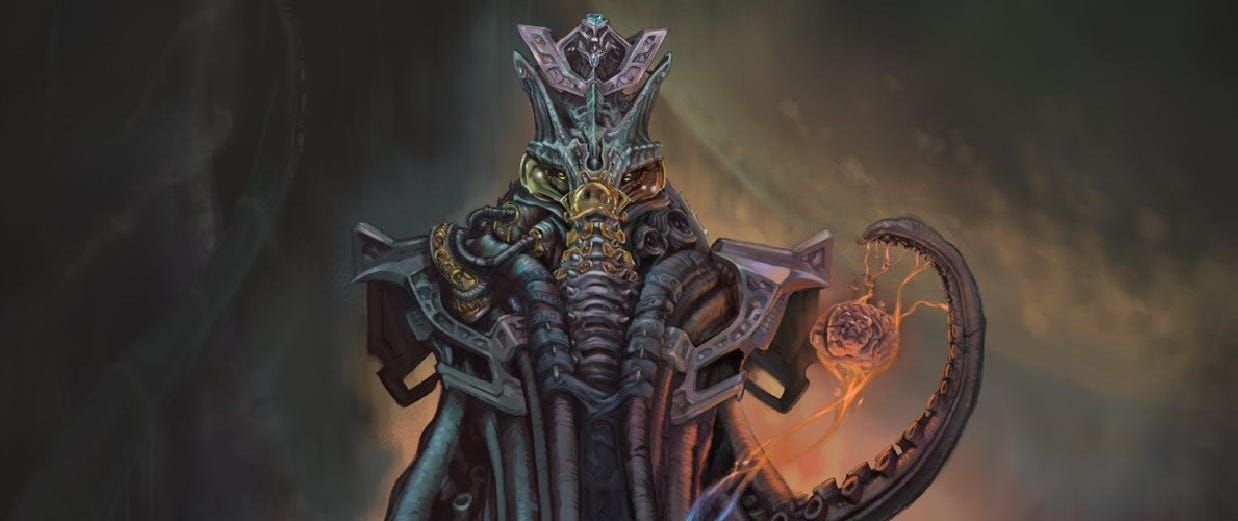Smash autonomous vehicles, upgrade magic items, and exploit your party’s worst fears
I couldn’t have run my D&D campaign without these third-party 5e supplements
Welcome back to Sebastian Yūe’s Newsletter! After seven years, 141 sessions, and 423 hours, my longest-running D&D campaign ended this month. We played from level 1 to level 15 in the world of Exandria, and I’m immensely proud of the story we told together. But I couldn’t have run the campaign without third-party material, and I’d like to share with you which books I used, and how I used them. Even though I’m a game designer myself, using third-party content allowed me to spend less time balancing combats and more time developing the plot and adding surprises for the players, which for me is the most fun part of session planning.
Introduction
Before I get into it, there’s a little context you need to know: I started this game as a player. My friend Morgan created the campaign and ran it until the start of the pandemic. I became the DM after we returned from hiatus, preparing six arcs and running five of them.
While I was the DM, my character became an NPC and continued to travel with the party in a reduced role. I wasn’t intending on including an arc for him, but Morgan kindly offered to run one. I just had to provide her with the overarching story and content for it. She took over for 17 sessions, then we co-ran the final session to close it out.

Our characters are as follows:
Adhlea Lavell (she/her), eladrin archfey warlock who researches magical anomalies
Odile “Larkspur” Tchaikovsky (she/her), high elf phantom rogue who wants to kill her last remaining family member
Mengdivad “Vim” Vimshaaxud (he/him), bronze dragonborn peace cleric of the Lawbearer who lost everything in the fall of Draconia and who wants to help the ravenites
Ptemfuzhi “Ptem” Vioclarukheo (she/he), drow chronurgy wizard, artificer, and order cleric who is trying to return to her home timeline and save her people from
I took the party to Emon for some downtime, then to the Dreemoth Ravine and ruins of Draconia for Vim, Syngorn for Larkspur, Westruun, and Xhorhas. We also did a time travel arc where we went to three homebrew locations, then finally returned to Emon to end the story.
I’m presenting the third-party material in rough order of appearance in the campaign, though some content is grouped together where it makes sense.
Tal’Dorei Campaign Setting Reborn (Darrington Press)

I’d never seen Critical Role when I started playing and was wholly unfamiliar with Exandria. We started with the original Tal’Dorei Campaign Setting (Green Ronin); by the time I took the reins, Tal’Dorei Campaign Setting Reborn was out. I used the sections pertaining to Emon for party downtime, Gilmore’s Glorious Goods, and the Primordial Children quest; Syngorn for Larkspur’s hometown (we all loved the Feygrove); and Westruun for a deck of many things arc.
I also used the Explorer’s Guide to Wildemount to create arcs in the ruins of Draconia, where the Bones of Frigid Doom plot hook inspired an arc about a necromancer who was trying to resurrect Vorugal as a dracolich, and Xhorhas so Ptem could meet the drow of the Kryn Dynasty and learn more about dunamis.
The Deck of Many Animated Reference Cards (Hit Point Press)
You’ll see a fair amount of Hit Point Press material in this post. They kindly sent me all their reference cards when I joined the team, and I’ve received copies of the books that have released since then. By no means is this a sponsored post, but I do attest the quality of the products.
The Deck of Many Animated Conditions

I can’t run D&D combat without these reference cards. Every week, the Deck of Many Animated Conditions saves me from mixing up the effects of conditions in 5e. I told my boss that this deck is the single most useful product that Hit Point Press has ever made, and I stand by that. I’m hoping condition cards return for the 2024 line.
The Deck of Many Animated Townsfolk

I looked to the Deck of Many Animated Townsfolk for inspiration when creating NPCs whom the party could meet during their downtime in Emon. Not only are the animations charming, each card comes with name options for the NPC, suggested stat blocks, a random table, and an in-character quote. I modelled a few NPCs after these cards; the most prominent one was a friend of Vim’s, a blue dragonborn tailor called Jehan. They were responsible for making the party’s winter outfits when they travelled to the ruins of Draconia in Wildemount.
The Deck of Many Animated Things

Even knowing how it could derail the campaign, I couldn’t resist giving my players a deck of many things. I love chaos and I love this item. The Book of Many Things had also released around the time I was running this arc and I was able to run a whole storyline around the deck. Larkspur pickpocketed the deck of many things from an NPC who had stolen it from Vorugal’s hoard in the ruins of Draconia, and she drew from it before selling it to the Grim Harrow for 100,000 gp.
I held the Deck of Many Animated Things up to the camera and drew one card, per Larkspur’s player’s request. Unfortunately for her, she drew Euryale.
The card’s medusa-like visage curses you. You take a −2 penalty on saving throws while cursed in this way. Only a god or the magic of The Fates card can end this curse.
Not content with her bad luck, the player wanted to draw a second card. This time, she drew Talons.
Every magic item you wear or carry disintegrates. Artifacts in your possession aren’t destroyed but do vanish.
Luckily, the party had enough gold to replace most of Larkspur’s magic items, but the amulet of proof against detection and location gifted to her by her deceased husband was lost forever. I offered the chance to draw a third, but she declined, having had enough misfortune. It’s a real pity she didn’t choose to draw again; the third card was The Fates.
Combat Wheelchair (Mark Thompson)

A council of corrupt chronomancers locked Ptem in an extradimensional prison, an experience that left her unable to walk independently for several in-game months, so she used the Combat Wheelchair by Mark Thompson. Ptem bought one in Emon and I used Raffe Ta’azen, a merchant mentioned in the supplement, as a vendor. I had a lot of fun with the mechanics; there were a couple of great moments when I used it to climb on the walls and ceiling of a dungeon to avoid a pit trap, and to run vertically down a sheer ravine face in Draconia. I also love the art in the supplement; Sethame V. Derat’s throne-like chair design inspired me to commission him for the illustration above.
The Griffon’s Saddlebag Book One (Hit Point Press)

The party were in Emon for Artisan’s Faire during the month of Brussendar, so I set up a market for them. I curated a selection of items that I thought they’d like, with many offerings from The Griffon’s Saddlebag Book One by Griffin Macaulay among them. Before the festival, Larkspur tried to burgle a mage in the Cloudtop District and landed herself in jail. Vim, being a cleric of the Lawbearer, arranged for a lawyer from his church to represent her and got her out with a community service sentence (which she shirked anyway). As thanks, Larkspur bought snugglebeasts for the whole party. Vim took the owlbear and named it Tsiliup (Draconic for “furry”), Ptem took the unicorn and called it “Taravanthas” (made up of the Elvish words for “gift” and “friend”), Adhlea took the dragon, and Larkspur took the tarrasque (neither elected to name theirs). Cuddling a snugglebeast lets you regain hit points if you spend Hit Dice during a short rest, and the party snuggled with them every single time. It was adorable.
Owlbear Plush (Baby Bestiary)

I didn’t technically need the owlbear plush to run the campaign, but look how cute it is! I picked this one up at Big Bad Con in 2023 so we could have a physical representation of Vim’s owlbear snugglebeast. If the Baby Bestiary ever does a unicorn, dragon, and/or tarrasque plush, I’m telling my group immediately so we can collect the whole set.
Big Book of Big Bads and Creatures & Curios (Hit Point Press)
I used content from The Big Book of Big Bads and Creatures & Curios for Larkspur’s Syngorn arc.
Big Bads 023: Exaxia

I used Exaxia by Jasmine Bhullar to fill the role of Larkspur’s undead-plant grandmother. Larkspur’s family had been experimenting with necromancy and poisoning the land, which made Exaxia a perfect fit for Larkspur’s backstory. The players enjoyed how Exaxia’s lair actions and legendary actions created acidic pools and corrupted vines, making use of the space and forcing them to move strategically.
Creatures & Curios: Driverless Carriage

My original Creatures & Curios pitch notes from 2022 refer to this monster as “a fantasy Tesla” and it has only become more relevant. I used it for an encounter in Syngorn where the Elvencraft Alliance went on strike because an “inventor” called Leon Husk forced them to make a driverless carriage and took credit for its design. The party killed Husk and staged the scene to look like he was hit by the carriage, and everyone got a kick out of it.
Token art by Nguyen Hieu, Nala J. Wu, Morgan Eilish, and SitoriC; map from Paizo’s Rise of the Runelords.
The Lich King’s Laboratory (DMs Guild)

The Lich King’s Laboratory by Morgan Eilish (also the founder of our campaign) ran this adventure as a fetch quest so we could retrieve the blood hourglass of balance (designed by Tomas Gimenez Rioja for Sigil’s Secret Menu) in order to cast the spell that would take the party to Ptem’s timeline. After that session, Morgan adapted the quest into this one-shot. It was a lot of fun to run through the puzzles and traps in Vecna’s abandoned laboratory and encounter the eccentric beholder who lives there now. At one point, Vim picked Ptem up and proceeded to slip on grease from the grease spell, toppling them both over, which was hilarious.
ARCADIA and Where Evil Lives (MCDM)
MCDM puts out some of the best 5e content on the market. I’m always impressed by the inventiveness of the design, and how fun and easy it is to run their monsters.
The Last Seven Notes, ARCADIA 30

I ran “The Last Seven Notes” by Sadie Lowry as a side quest; Vim cast planar ally for a celestial to help protect a ravenite settlement from an undead attack in the ruins of Draconia. The celestial agreed and asked Vim to complete this quest as payment. I reflavoured Paen Cathedral to be a temple to the Lawbearer, but kept the other adventure details the same. The party managed to help all the NPCs and play the song on the soulstrings instrument, calming Iahhel the celestial.
The Chained Library, ARCADIA 4
I used “The Chained Library” by Chant Evans because the party were looking for timeline identification codes they needed to go to Ptem’s home timeline. The party battled sentient grimoires, snuck to the deep stacks, surreptitiously perused some times and of course stole some of them. It was here that they found the stat-raising tomes and manuals, along with the event-altering artifact A Revised History of the World. That book turned out to be so powerful that even our sticky-fingered rogue was afraid to keep it.
The Magewright’s Studio, ARCADIA 28

Right at the end of the campaign, the party met the drow god of craft and they offered to upgrade the party’s weapons for the final boss fight. This upgrade allowed them to add one unique property to the weapon and I used the customisation options in “The Magewright’s Studio” by Chant Evans and Lore Evans, which are fantastic. Larkspur and Ptem chose Alacritous, which gives you one extra action or bonus action; Adhlea chose Protective for the +1 to AC, and Vim chose Preservative and it saved his life in the final boss fight against the god of memory.
Where Evil Lives: Terminal Excrescence

I’ve already extolled the virtues of Lord Syuul’s Terminal Excrescence lair by Carlos Cisco before, but it bears repeating just how good the encounters are. At this point, I wasn’t running the game, but I did suggest that we do the lair. In our story, Lord Syuul was hired by an enemy nation to create a creature capable of consuming souls. The party had to enter his facility and destroy both him and the soul-sucker. We killed Syuul and when we cast speak with dead on his corpse, he tried to persuade the party to bring him back to life in exchange for his secrets. Though Ptem was admittedly tempted, the rest of the party were sensible enough to know better. I as a player would have liked for my character to gain a body modification from Syuul’s enucleator but alas, Ptem thought the procedure was too invasive and not worth the benefit. Larkspur, however, chose the Relentless Toughness modification (akin to a troll’s regeneration), which came in handy during subsequent combats.
Fool’s Gold: Into the Bellowing Wilds (Hit Point Press)

Fool’s Gold: Into the Bellowing Wilds has a special place in my heart for being the very first thing I worked on at Hit Point Press. It has some great monsters; in the book, the foreclaimers are skilled arcane inventors who built their own automatons. When the party visited the craft god’s forge, they encountered a mirror knight and two chargers. The knight was programmed to run through a training sequence where it reflected attacks back on its attacker, but its input had long since expired. It identified the party as a critical threat but once they reduced it to half its hit points, it declared the training sequence completed and was able to share information about the dungeon with them. The party also constructed a mech of their own, for which I used the foreclaimer mech dragon’s stats as the base for the party’s mech.
Acererak’s Collection of Complex Traps (DMs Guild)

Also in the forge, I used Acererak’s Collection of Complex Traps to challenge the party. Specifically, I used Methil’s Wicked Mind Warp by Sven Truckenbrodt, Mistshadow’s Whispers by Jessica Marcrum, and Halaster’s Highway to Hell by Steve “Jaspor” Orr and the party ran into all three traps, which I hadn’t expected, as the first two were at opposite ends of a hallway. I particularly liked the opportunity to personalise the nightmarish experiences in Methil’s Wicked Mind Warp and Mistshadow’s Whispers (which I reflavoured to suit the god of the forge rather than Leira, but it still worked perfectly). Halaster’s Highway to Hell was the final trap between the party and the entrance to the forge itself, and its lava mechanic made it the perfect choice for that location.
Resources
These aren’t what I’d classify as “third-party content” but were nonetheless very useful when I was putting this campaign together.
RPGBOT.net
I referenced RPGBOT’s character optimisation guides often when I was looking for magic items to give the party. I’m not an expert on every class and the magic item lists were invaluable in choosing loot and available items for the characters.
Fantasy Name Generator
Fantasy Name Generator saved me not only when I’d forgotten to name random NPCs, but also when I needed book titles and restaurant names. The party developed a habit of finding the worst romance novels and reading them before bed together; some favourites were Pirates without Sin, Blacksmiths and Enemies, and My Beloved in the Forest. For restaurants, we got the Solar Bear Steakhouse and the Entertaining Hippopotamus Tavern, which we translated into Italian for La divertente taverna dell’ippopotamo.
Planning the Ending of a Campaign | RPG R&D Podcast 2025
If you’re curious about the specifics of ending a campaign, I talk about it on the RPG R&D podcast. I planned the ending with the players in the sense that I made sure everyone would be happy with where their characters ended up, but I also gave them some surprises. I wrote their characters some in-universe letters from the NPCs they’d helped to give the players closure, showing that their characters’ actions had tangibly and permanently made a difference.
Have you ever used third-party content to build your D&D campaign? Let me know in the comments!





It makes me nostalgic reading your post about finishing a long campaign, having done the same with my 1-17 level one (only we stopped and never actually finished it). Great seeing all the amazing third party content you used to tailor your story!